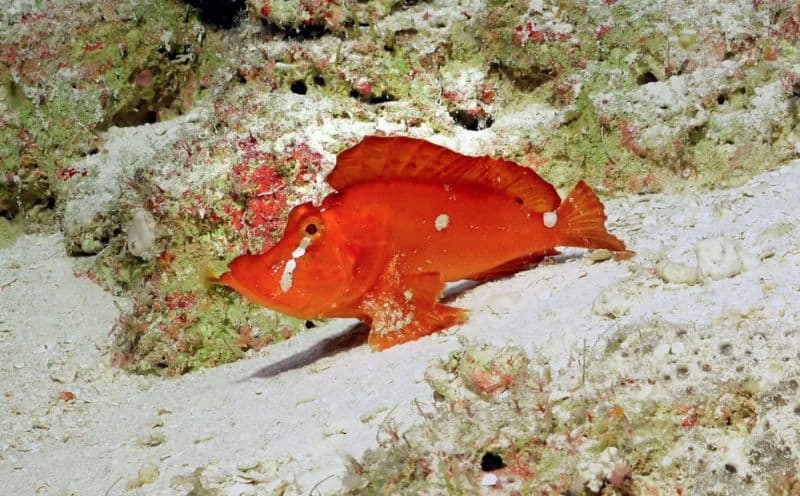For the first time, scientists have viewed the deepest regions of the Great Barrier Reef Marine Park and discovered, among other things, an extremely rare fish that appears to “walk” along the seafloor.
Researchers say it propels itself along the seabed using its pectoral fins, and its motion in doing so is described as “an awkward, lumbering gait”.
Well-camouflaged ambush predator
Scientists aboard the RV Falkor, an oceanographic research vessel from the Schmidt Ocean Institute, say it is the first recorded observation in Australian waters of the fish, whose scientific name is Rhinopias agroliba. It is a colourful and well-camouflaged ambush predator in the scorpionfish family.
“It was very strange — it had this beautiful red colour and it walked on its pectoral fins like a set of hands,” Robin Beaman of James Cook University told ABC News.
He added that the closest known sighting of the fish was off the coast of Hawaii, so this was “a huge range extension”.
Discovered five undescribed species
According to a statement released by the US-based Schmidt Ocean Institute, it is the first time scientists have viewed the deepest regions of the Great Barrier Reef Marine Park.
In doing so, they discovered five undescribed species consisting of black corals and sponges, took the deepest samples ever collected of soft coral and scleractinian coral in the Coral Sea, and collected the first sample of ancient bedrock beneath the Great Barrier Reef, estimated to be between 40- and 50-million years old.
They also took critical habitat samples that will lead to a greater understanding of the spatial relationships between seabed features and the animals found in the Coral Sea.
Robot explored floor at 1 800m
The research, described as complex and scientifically challenging, was completed aboard the vessel Falkor as part of the Institute’s Australia campaign.
Using a remotely operated underwater robot to view high-resolution video of the bottom of the ocean floor, at some 1,820 meters deep, the science team examined deep sea bathymetry (the study of underwater depth of ocean floors), wildlife and ecosystems.
Answering a range of questions
The collaborative mission brought together scientists from Geoscience Australia, James Cook University, University of Sydney, Japan Agency for Marine-Earth Science and Technology (JAMSTEC), Queensland Museum Network, and Queensland University of Technology, to answer a range of questions about the geological evolution and biology of the deep sea canyons and reefs.
“Schmidt Ocean Institute and the technology that it has brought to Australia is a huge enabler in better understanding our marine resources from a lens of diverse disciplines,” said Dr Scott Nichol, one of the lead expedition scientists from Geoscience Australia.
“This work brings new understanding and will keep the scientists busy for years.”
In 2020 walking fish is back in the news as part of a gambling app controversy
Fish has appeared recently as a logo of Big Fish Games, a game studio stirring controversy in the media following various stories about people losing their money in casino-style games they produce. Some people lost up to $150,000 according to an NBC article that sheds more light on the story. Compared to online casinos where players can win real money, the apps distributed by Big Fish Games don’t really offer anything in return, but consume players’ time and money. similarly to their Great Barrier Reef brand inspiration, they too are a “well-camouflaged ambush predator” as reported above.












